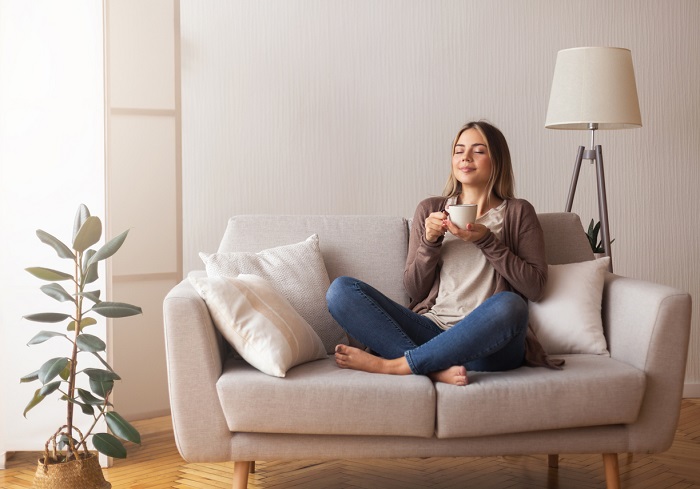After a long, hectic day at work, all you can think about is heading back home to plop on the sofa and never get up again. However, if your cushions don’t make you say “Ahh” when you land on them at the end of the day, you may need to consider what material they are actually filled with.
There are many types of fillings and materials that can be used for furniture. Some make the cushions soft and comfy where you can just sink into, whereas other materials give them a more firm and supportive structure. Each material is used differently and applied for less traffic or more traffic areas accordingly.
You may not have thought about this, but your lifestyle can play a huge role in helping you decide what to fill your furniture with. To make sure your furniture is as comfortable and inviting as ever before, let us breakdown the best types of materials to fill it with.
Foam
When breaking down which materials to fill your furniture with, the most popular filling is foam. Foam is the most commonly used material because it offers several different options and densities, depending on what kind of support and firmness is preferred.
When it comes to foam fillings, you will have a number of different density options to choose from:
- Low-density foam: Has a softness to it that tends to flatten faster.
- High-density foam: More of a harder fill, but it does get softer with time and weight.
- Memory foam: Conforms to the body and provides great support – perfect for those with joint and muscle pain.
- High-resilient density (HR): Resistant to sagging and wearing and can last for up to 14 years or longer.
Within the foam category, there are also a few more specific options: molded foam, all-foam, spring down or blend down. These foams all range from high to low density, as well as memory foam. Each of the uses can differ, it all just depends on what kind of support you’d like.

Hollow-fill Fiber
While foam does offer various options, it is certainly not the only type of comfortable furniture filling. Another great choice of material to go with is hollow-fill fiber filling. Hollow-fill fiber is squishy and soft, which makes it perfect for an afternoon nap.
While hollow-fill doesn’t offer any actual support, it is perfect for sofas or other pieces of furniture that are used for napping or lying down for short periods of time. In fact, the cushions are so soft that when you get up, you will see your imprint on them! If you do go with hollow-fill fiber, we recommend rotating them regularly because they tend to soften quicker than you’d expect.
Feather
One filling material that has been around for a very long time (and for good reason), is feather. Feather cushioning is pretty self-explanatory as far as support goes because they come made to order. You can increase the number of feathers for firmer support or decrease the amount for a softer seating.
Another important note to add; the more feathers in the cushion, the more you will have to plumb them around or they will clump together. With some regular fluffs here and there, feather filling is a solid furniture material to go with if you’re looking for something versatile and reliable.

Polyester
If you’re looking for an exceptional type of material to fill your furniture that’s also easy on your wallet, polyester filling is the way to go. Polyester fillings offer smoothness, durability, bounciness, and are available in several different densities, however, it does flatten out easily.
If you decide to go with polyester fillings, there are several types to pick from that address different needs:
- Ply-a soft polyester: Doesn’t bounce back and is limp in structure.
- Faux-down polyester: Gives the look and feel of down clusters – it’s less expensive and great for people who are allergic to feathers.
- Cluster polyester: Consists of tiny fiber balls, making it long-lasting and durable.
Batting
The last type of filling material we wanted to cover that will be sure to catch your attention is batting. Batting filling is very unique because it provides insulation as well as cushioning, and comes in two sizes of thickness: 25.5 ounces and 42.4 ounces.
Typically, batting is made from polyester, wool, or cotton; although, cotton batting is susceptible to poking through sofa cushions so that’s something you’ll need to keep in mind. If your sofas are used quite often, then consider a polyester-cotton blend over wool. Wool degrades quickly and isn’t ideal for living room and lounge couches.

At the end of a long, grueling day, you deserve to come home and kick your feet up. And your furniture should be there ready to induce you into instant relaxation as soon as you sit or lay down.
The type of material you fill your furniture up with can have a major impact on that, and that’s why it needs to be considered when purchasing a new piece of furniture. If you’re still unsure about which filling to go with, the type of material you choose strictly comes down to supportive needs and personal preference.
But if you think it is time for a comfort upgrade, we offer a top selection of sofas, sectionals, chairs, and other home furnishings that will be sure to bring you immediate comfort the day you bring it home. If you have any questions, give us a call , browse our digital catalog , or visit us in person to shop our entire collection of top-rated home furnishings today!